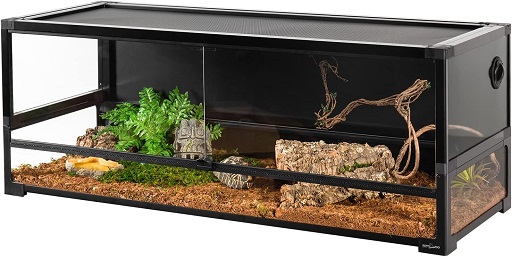A 75-gallon reptile tank is a spacious enclosure suitable for housing various reptile species. This size provides ample room for your pet to move around, which is essential for their physical and mental well-being. Here are some considerations and tips for setting up and maintaining a 75-gallon reptile tank:
Key Considerations:
- Species Suitability:
- Bearded Dragons: Ideal for adult bearded dragons, providing enough space for their activity and thermoregulation.
- Ball Pythons: Suitable for adult ball pythons, offering enough room for them to stretch and explore.
- Leopard Geckos: A 75-gallon tank can house multiple leopard geckos, though careful monitoring and proper husbandry are needed.
- Turtles and Tortoises: Some species of turtles and tortoises can thrive in this size tank, but ensure it meets their specific requirements.
- Temperature and Humidity:
- Heating: Use heat lamps, ceramic heat emitters, or under-tank heaters to create a temperature gradient. Ensure the tank has a hot side and a cool side.
- Humidity: Maintain proper humidity levels using misting systems, humidifiers, or water bowls, depending on the species’ needs.
- Lighting:
- UVB Lighting: Essential for species that require UVB light for calcium metabolism, such as bearded dragons and tortoises. Use appropriate UVB bulbs and replace them every 6-12 months.
- Day/Night Cycle: Provide a natural day/night cycle with a timer for the lights.
- Substrate:
- Choose a substrate suitable for your reptile species. Options include reptile carpet, paper towels, tile, or specific substrates like coconut fiber, sand, or soil blends.
- Decor and Enrichment:
- Hides: Provide multiple hiding spots on both the warm and cool sides of the tank.
- Climbing Structures: For arboreal or semi-arboreal species, include branches, vines, and other climbing structures.
- Water Dish: Ensure a clean water source is always available. For aquatic species, a swimming area is necessary.
- Ventilation:
- Ensure proper ventilation to prevent mold growth and maintain air quality. Screen lids or tanks with built-in ventilation are recommended.
Setup Tips:
- Tank Placement: Place the tank in a location away from direct sunlight and drafts to maintain stable temperatures.
- Secure Lid: Use a secure lid to prevent escapes and to protect your reptile from other household pets or hazards.
- Cleaning: Regularly clean the tank to prevent the buildup of waste and bacteria. Spot clean daily and do a thorough cleaning periodically.
- Monitoring: Use thermometers and hygrometers to monitor the tank’s temperature and humidity levels. Adjust as necessary to maintain optimal conditions.
Conclusion:
A 75-gallon reptile tank offers a versatile and spacious environment for various reptile species. Proper setup and maintenance, including appropriate heating, lighting, substrate, and enrichment, are crucial for the health and well-being of your reptile. Always research the specific needs of your reptile species to ensure you provide the best possible care.
